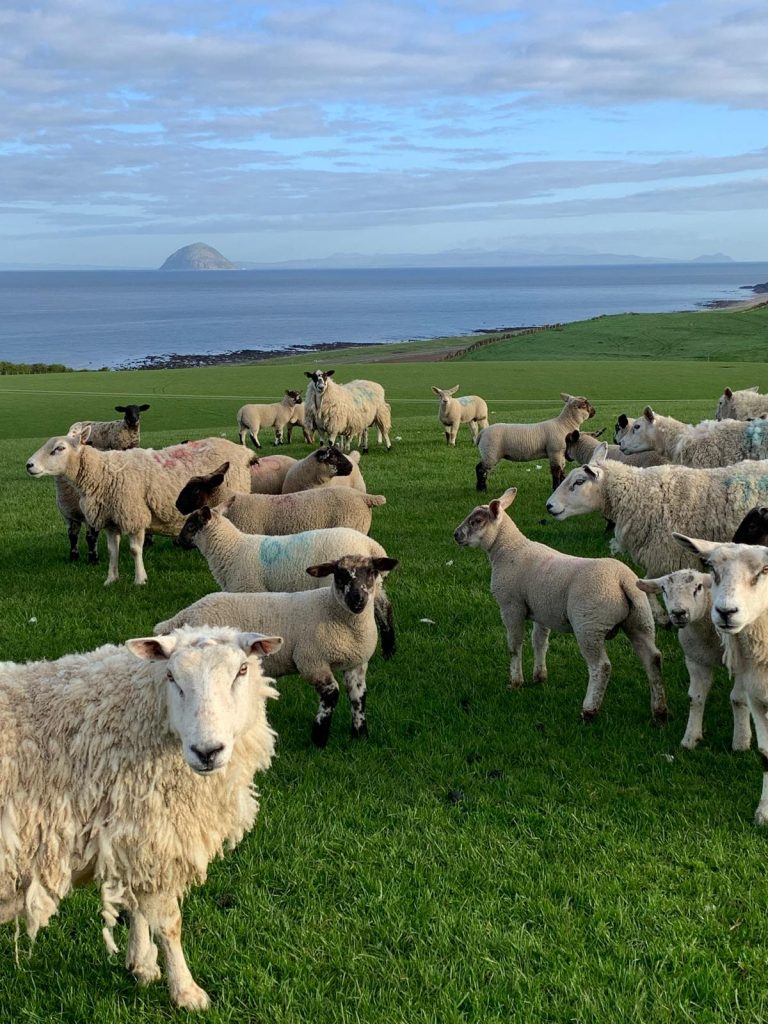
“We have been using Lamb Feeder for the last 17 years (since 2007) and find it does a great job, we would be very reluctant to feed anything else” says Andrew MacLean, farm manager at Kings Arms Farm, Ballantrae, Ayrshire.
Now in his 31st year with the Dalrymple family, Andrew MacLean manages three farms off the Ayrshire coast at Ballantrae, with 350 acres at Kings Arms just by the sea shore, Crailoch with 350 acres of hill and reclaimed inbye two miles in and 250 acres of rented ground three and a half miles further in.
The sheep flock of 1450 ewes comprises 450 Scotch Mules and 1000 Texel x Mule ewes. The Scotch Mules – which includes 130-140 gimmers purchased annually – go to the Texel tup to produce Texel x Mule ewe lambs for breeding the following year.
Texel gimmers are put to a Beltex x Suffolk tup, with the aim of producing a slightly smaller lamb which is ‘not so sore’ on the gimmer. 150 of the 300 hoggs get one turn of a Beltex tup around three weeks later than the main tupping with the aim of getting 100-120 in lamb. “We are trying to get them to lamb alongside the last of the ewes and it is definitely a ‘work in progress’.” says Andrew.
We run the home bred Texel x Mules with the Suffolk tup to start until we get 700 tupped. This gives the early lambs for finishing on Harbro Lamb Feeder. The remaining ewes go to Beltex x Suffolk tups with their progeny finished on grass.
“The minute I see lambs nosing at the ewe feed, we get the creep feed out, usually the middle of March when the lambs are about three-four weeks old. We only put out a small amount, keep it fresh and let them nibble a little.
We leave these early lambs entire, finding that we get quicker growth and a faster finish on the Lamb Feeder, getting all lambs away by the end of June.”
The Harbro team explains that this is one of the key features of Lamb Feeder. “Young lambs have built in feed efficiency, meaning we can feed less for more gain. This, along with the high quality, energy dense Lamb Feeder means lambs might only eat around 3kg of feed to gain 1kg weight whereas an older lamb or lambs on other feed may need closer to 5kg of feed to gain 1kg.”
“We start to weigh lambs in mid-April and by the second or third week of May, we’ll have the first decent draw of lambs. Since 2010, lambs have been consigned to Woodhead Bros through Ayrshire Country Lamb, killing out at 21kg average.” says Andrew.
“We are aiming to have 80% of our lambs in the E and U grades and in 2018 when we hosted Scotsheep, we achieved 88%.
We feed 50% of the lambs – approximately 1100 – on creep, these being twins, triplets and larger singles. Into June, we are starting to draw off grass fed lambs. We find the Beltex cross lambs finish particularly well on grass, they kill out well and it saves us using feed at both ends.
Creep feeding lambs let us get them away early and get a premium. The ewes go onto barer ground leaving us to utilise early grass for cows and calves over the summer. Using creep feed allows us to have a bigger turnover of stock and carry more ewes – allowing four ewes with twins per acre – so it is a ‘win win’ situation.”
Ewes are housed and scanned in mid-December, with lambing commencing on 17 February, all inside at Kings Arms. “Ewes are fed Clover Premium ewe rolls which we have fed for nearly 20 years. The most important thing for me is a milky ewe with quality colostrum, and to get lambs up quickly on their feet.
The weather at lambing can be pretty harsh or extremely wet (with this one being the exception!). If a lamb has a belly full of quality milk, it’s amazing the difference it makes, a hungry lamb is not long in going down.”
“We try to make the best silage we can, get it analysed and feed accordingly and find Clover Premium Ewe gives us the correct balance of nutrients, minerals and vitamins. Sheep are finicky when it comes to feed and it is important for us that the formulations and ingredients remain the same during the season. We have a good rapport with Emily, our Harbro specialist and she is always available on the phone should we need anything.”
Splitting bullocks and heifers key to success
In addition to the sheep, just under 200 head Limousin x Friesian and Aberdeen Angus x Friesian cattle are put to the Charolais to produce stores. 12 pedigree Charolais are kept mainly for breeding bulls for the farm. Any surplus bulls are out-wintered and sold off the shore at two years old.
Cows have access to Super Suckler SEC buckets over the summer and are fed Easy Calver minerals pre- and post-calving. “A long time ago, we were having problems with calves getting on their feet and sucking. We’ve been using Easy Calver for the last 15 year now and it has definitely made a difference, calves are a lot more active when they are born, up and sucking. It was like night and day when we started using it.
Since we started with Harbro for cattle feed, we have been split the heifers and bullocks for feeding and this has made a huge difference. Bullocks are fed Beefstock with heifers receiving Calf Rearer. We found the heifers were ‘getting fat rather than growthy’ and since moving them to Calf Rearer, an 18% protein feed, we have found that it grows them much better, ready for going away at 10-12 months through United Auctions at Stirling.”
